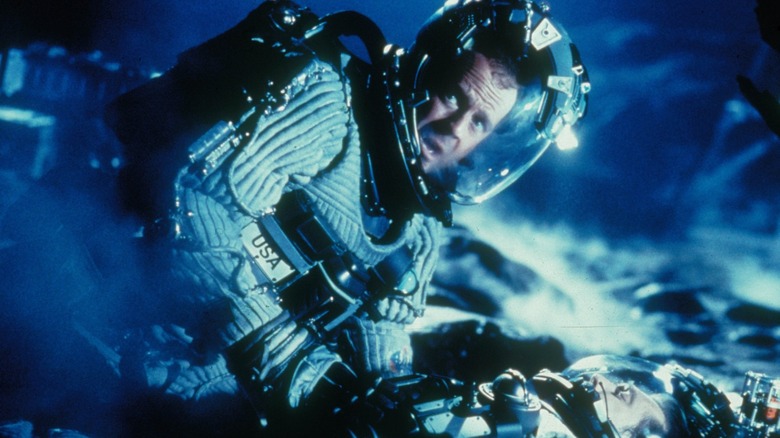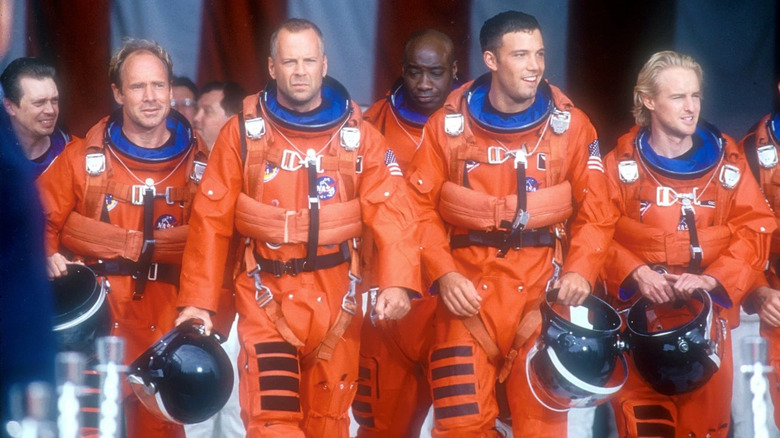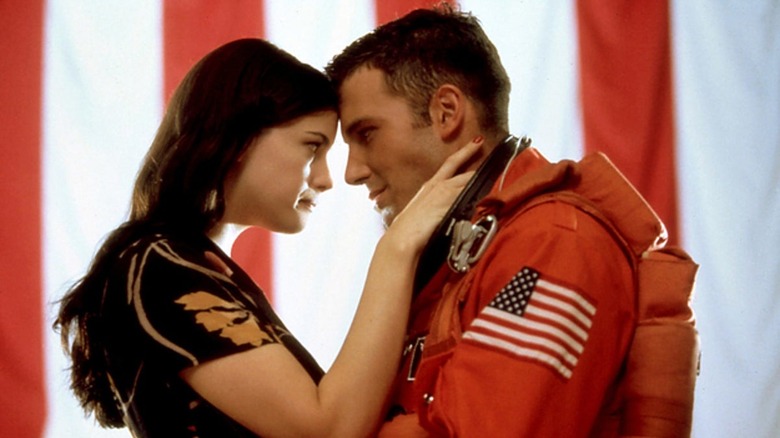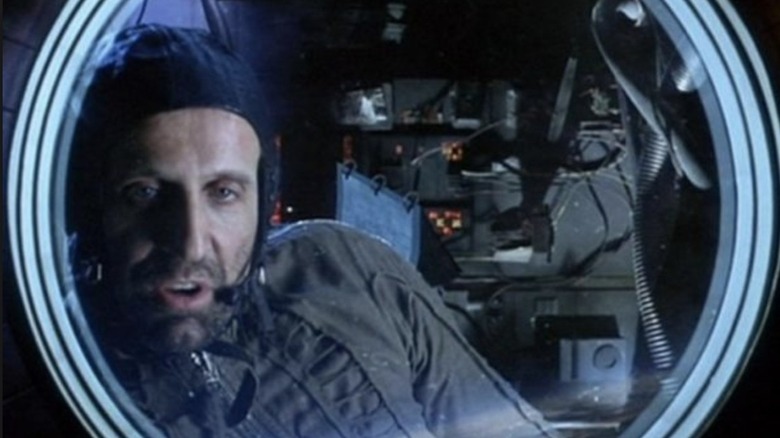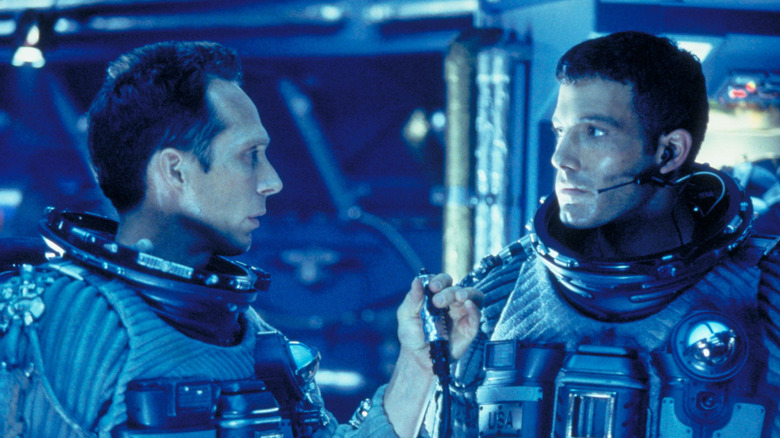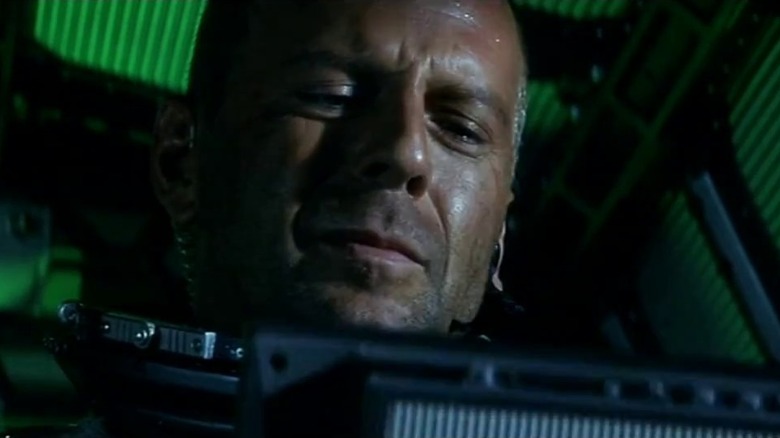Armageddon Ending Explained: We Don't Want To Miss A Thing
A few weeks ago, NASA made history by slamming a spacecraft into an asteroid seven million miles away from Earth to see if it could successfully change its course. The lump of rock posed no threat to our planet, merrily minding its own business on its way toward the sun, but the mission was a success. The DART (Double Asteroid Redirection Test) impact exceeded expectations, shortening the asteroid's orbit around its larger parent by 32 minutes instead of the hoped-for 10 minutes. The experiment raised hopes that if an asteroid was on collision course with Earth, we could actually do something about it.
It was like something out of a Hollywood movie, and no doubt prompted many people to dust off their copies of "Deep Impact" and "Armageddon" in celebration. Both films hit theaters in 1998, one of those weird cinematic instances when two movies about exactly the same thing drop within a few months of each other. Even the posters were pretty similar.
Both movies had basically the same plot, focusing on efforts to stop an extinction-level event from a huge lump of rock hurtling towards our planet, but their approaches were much different. Mimi Leder's "Deep Impact" arrived first, a somber character-driven story that spent way too much time with Elijah Wood while Robert Duvall doddered about in space. Then came "Armageddon," Michael Bay's gung-ho space adventure that correctly understood that disaster movies are supposed to be fun.
Both movies made a significantly deep impact at the box office but Bay's film won the battle of the Global-killer killers, even earning an unlikely place in the Criterion Collection. Let's take a closer look at how that one played out.
So what happens in Armageddon again?
"Armageddon" opens with a devastating meteor shower hitting New York City, but it is only a prelude to a far more cataclysmic event. A rogue comet has sent an asteroid the size of Texas hurtling towards Earth, due to hit in 18 days with global-killing consequences.
Bruce Willis plays Harry Stamper, a hardened oilman who NASA figures is the perfect person to train a team of astronauts to drill a hole in the asteroid and plant a nuke, with a view to splitting it in half so both parts will narrowly miss our planet. When we first meet him, Harry is driving golf balls from his rig at a do-gooder Greenpeace vessel before trying to shoot the guy dating his daughter. He's a maverick who does things his way, and only agrees to the mission if he can take his own crew along.
Harry's guys are a bunch of good-natured roughnecks and misfits, including his level-headed best friend Chick (Will Patton), horny goofball genius Rockhound (Steve Buscemi), and laid-back Oscar (Owen Wilson). Then there is hotheaded A.J (Ben Affleck), who isn't in Harry's good books because he's sleeping with his daughter Grace (Liv Tyler).
After a whirlwind training program, Harry and the gang are flown to the asteroid in two top-secret military shuttles named "Freedom" and "Independence." Along the way, they stop off for fuel at a decrepit Russian space station where they pick up cranky Cosmonaut Lev (Peter Stormare) after the whole thing blows up. Slingshotting around the moon to intercept the asteroid is only half the battle and the landing approach is perilous. "Independence" crash lands, killing half the crew. Can the survivors reach the other team and get the job done before the asteroid passes "Zero Barrier"?
Does Armageddon still hold up?
If anything, "Armageddon" plays better today than it did when it was first released. Apart from the cuss words, a strip joint scene, and a running joke about Rockhound's penchant for underage girls, it almost passes as wholesome family entertainment. It may be noisy and overly macho, but it also has strong themes of family, friendship, loyalty, bravery, and self-sacrifice, with a little global unity thrown in for good measure.
"Armageddon" was derided at the time, earning several Golden Raspberry nominations, and Bay even apologized for the film's editing back in 2013. Maybe because we're attuned to the incoherence of many modern blockbusters, the pace and editing of "Armageddon" now seem breakneck but completely lucid. I'm never confused about who is doing what, where, or why, and Bay handles the thrills expertly. He's a showman who knows what works, giving us two beat-the-countdown nail-biters to go with the intense peril faced by the crew on the surface of the asteroid.
The visuals hold up incredibly well with a judicious mix of CGI and physical effects. The design of the asteroid might not be scientifically plausible but makes sense on a gut level, a gnarled thing wreathed in sinister vapors like some malevolent monster hellbent on destroying our planet.
With its mix of action, comedy, and romance, "Armageddon" is pretty irresistible. The characters are painted in broad strokes but, with a cast like this, you can't help rooting for them. Bay's movies are usually quite cynical, but he leans into sentimentality here and it pays off in the emotional finale; you must be a very hard person if you don't have a tear in your eye at the end.
The trip to the asteroid
Michael Bay has only ever paid a passing nod to reality in his films, which makes it tricky to explain the flurry of plot points out in space without getting sucked into the black hole of what is scientifically accurate or not; there are dozens of articles out there picking it apart if that's your thing. As Bay said (via New York Times):
"'Armageddon' is like a total fantasy for a 15-year-old. It's funny — when the critics tried to review 'Armageddon.' I mean, relax, it's a popcorn movie. It's not supposed to be taken seriously. It's a fantasy world."
So let's try to keep it within the logic of the film. The first port of call when the shuttles leave Earth is the Russian space station to top up on liquid oxygen fuel. We see both spacecraft jettisoning their solid rocket boosters and external fuel tank as they leave the atmosphere, so this will be the juice they need for the next stage of their journey: A burn around the moon to intercept the asteroid as it passes.
Approaching the asteroid from behind is a safer bet, particularly since it is hurtling through space at 22,000 mph and is preceded by a field of debris. The slingshot move is a legit way to build the speed necessary to catch up with it; in 2013, the Juno spacecraft performed a slingshot around Earth to give it a much-needed boost on its way to Jupiter. We are also told that the Moon's gravity will clear away some of the trailing debris, but since the asteroid zips past so quickly it doesn't have much effect, leaving plenty of deadly rocks to negotiate on the way to the planned landing site.
The secondary protocol
Any good disaster movie needs a human villain, too, and the closest we get in "Armageddon" is General Kimsey (Keith David), who is all for hitting the asteroid with a barrage of nukes despite good advice that it won't have much of an effect. He is also in charge of implementing the Secondary Protocol, a fail-safe secretly put in place to detonate the nuclear warhead remotely if the drilling doesn't go to plan. Up on the asteroid, Colonel Willie Sharp (William Fichtner) has instructions to make sure no one interferes with the Secondary Protocol if it is called into action.
To split the asteroid, Harry's team needs to drill a hole 800 feet deep for the bomb, which is harder than expected because they miss their planned landing site and find themselves digging through compressed iron ferrite. To make matters worse, an unforeseen effect of the Moon's gravity sends the asteroid spinning erratically on its axis, causing the team to lose radio communication with Earth.
The loss of signal also means that, with the drilling going badly, the President only has a few minutes to decide whether to initiate the Secondary Protocol as there is no guarantee that radio communication can be re-established before the asteroid passes Zero Barrier. Without a signal, there is no way to remotely detonate the bomb. The President gives the nod and Kimsey activates the warhead, despite the best efforts of the NASA team to delay it.
Luckily for all humanity, good old Harry Stamper is a man of his word and is able to convince Sharp that he will hit the 800 feet required. Cue a classic bomb-defusing scene before the guys can get back to work.
A tearful goodbye
With the hole dug and time still on the clock, another disaster strikes; the drill site is bombarded by a sudden rock storm, damaging the remote detonator on the bomb. This means someone has to stay behind and set it off manually. The remaining crew, apart from the shuttle pilots and Rockhound who is suffering from "space dementia," draw straws to see who will be posthumously celebrated as the guy who saved the planet.
A.J. draws the short straw leaving Harry with a dilemma; not only did he promise his daughter he would return, but he also swore he'd bring her future husband back alive, too. Harry goes through the motions of pretending he'll let A.J. go ahead with it before stuffing him back in the airlock and taking on the responsibility himself.
"Armageddon" finds its true heart in these hectic final scenes. It may be a big dumb movie about saving the planet from a massive rock, but on a smaller scale, it is about family; the relationship between Harry and Grace; the future family as Harry gives A.J. his blessing and says he loves him like a son; and the "Fast & Furious" family sense between Harry and his crew, who all feel like fathers to Grace. Then there is the global family; "Armageddon" might be an America-saves-the-world story, but Bay pays a small tribute to the notion of every nation on Earth united against a common threat. He also lets Lev, representative of the old Cold War enemy, save the remaining crew by fixing the shuttle at the last moment so they can escape the asteroid.
Critics love bashing Michael Bay as a cynical hack who favors guns and explosions over people and feelings, yet, at the end of "Armageddon," he reveals a humanist streak that makes it his masterpiece.
